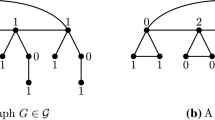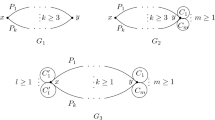Abstract
For a graph \(\Gamma \), a subset \(S\subseteq V_\Gamma \) is known to be a dominating set, if every \(x\in V_\Gamma {\setminus } S\) has at least one neighbor in D. The domination number \(\gamma (\Gamma )\) is merely the size of a smallest dominating set in \(\Gamma \). The strong product \(P_r\boxtimes P_s\) of two paths \(P_r\) and \(P_s\) is known as the king’s graph. Interestingly, the king’s graph is isomorphic to the two-parametric family of cellular neural network (CNNs). In Asad et al. (Alex Eng J 66:957–977, 2023), the authors retrieved certain structural characteristics of CNNs from their minimal dominating sets. They conjectured in Problem 8.3 that the domination number of \(P_r\boxtimes P_s\) is \(\Big \lceil \frac{r}{3}\Big \rceil \Big \lceil \frac{s}{3}\Big \rceil \). This paper solves Problem 8.3 by providing a proof to the conjecture. This result, in turn, reveals interesting topological properties such as an optimal routing for this class of neural networks.

Similar content being viewed by others
Data availability statement
Data sharing is not applicable to this article as no datasets were generated or analyzed during the current study.
References
Chartrand G, Zhang P (2013) A first course in graph theory, Courier Corporation
Haynes TW, Hedetniemi S, Slater P (1998) Fundamentals of domination in graphs. CRC Press, New York
Khan A, Hayat S, Zhong Y, Arif A, Zada L, Fang M (2023) Computational and topological properties of neural networks by means of graph-theoretic parameters. Alex Eng J 66:957–977
Acknowledgements
The authors are indebted to Yubin Zhong for proposing this problem.
Funding
Sakander Hayat & Haziq Jamil are supported by UBD Faculty Research Grant (No. UBD/RSCH/1.4/FICBF(b)/2022/053)
Author information
Authors and Affiliations
Contributions
The authors declare that the study was conducted in collaboration with equal responsibility. All authors read and approved the final manuscript.
Corresponding author
Ethics declarations
Conflict of interest
The authors declared that they have no conflict of interest regarding this manuscript.
Additional information
Publisher's Note
Springer Nature remains neutral with regard to jurisdictional claims in published maps and institutional affiliations.
Rights and permissions
Springer Nature or its licensor (e.g. a society or other partner) holds exclusive rights to this article under a publishing agreement with the author(s) or other rightsholder(s); author self-archiving of the accepted manuscript version of this article is solely governed by the terms of such publishing agreement and applicable law.
About this article
Cite this article
Arshad, M., Hayat, S. & Jamil, H. The domination number of the king’s graph. Comp. Appl. Math. 42, 251 (2023). https://doi.org/10.1007/s40314-023-02386-8
Received:
Revised:
Accepted:
Published:
DOI: https://doi.org/10.1007/s40314-023-02386-8




